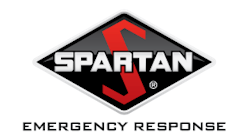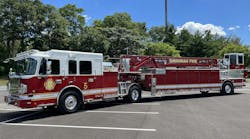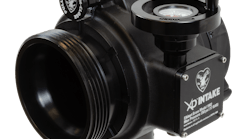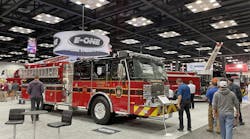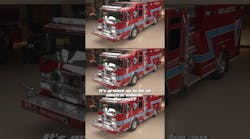When the economy is weak, or faltering, as it has been for the past couple of years, people try to cut back and make what they have go further and do more. There's no exception when it comes to fire apparatus.
As the economy continues to wring the life out of the fire service and staffing, communities squeeze more out of the equipment they purchase. That's why there seems to be a huge surge in the manufacturing and interest in multi-purpose apparatus.
While apparatus that has more than one use is not a new concept, as quints, rescue engines and pumper tankers have been around for years, it seems communities are becoming more particular when it comes to their apparatus needs and looking to manufacturers to become more and more innovative with their apparatus designs.
This is the first article in a series planned for 2011 on apparatus-related topics by Firehouse® Magazine and Firehouse.com. For expanded coverage, including photos and audio podcasts, go to http://www.firehouse.com/0111-apparatus.
"With the economic constraints we're now under, people are trying to get more bang for the buck," said Bryan Smeal, regional sales director for Smeal Fire Apparatus in Snyder, NE. "They are looking to combine vehicles. If they're looking at a pumper and a rescue, maybe they'll start thinking about combining those and not replacing the rescue."
The numbers seem to bear witness to that concept. Apparatus manufacturers have seen a steady decline in the number of units purchased annually. According to figures from the National Fire Protection Association (NFPA), 6,102 apparatus were sold in 2008 and 4,200 in 2009. And from anecdotal information from manufacturers, it appears that 2010 will tally in at 10% less than 2009 and another double-digit dip is predicted for 2011.
"It's unprecedented," said Bill Doebler, vice president of sales and marketing for Crimson Fire, an apparatus maker in Brandon, SD, of the apparatus sales slowdown. "I've been in this business 21 years and I've never seen anything like this."
Alan Saulsbury, a fire service marketing consultant in Homer, NY, has been in the fire service for at least 40 years and he too said he has not experienced this kind of slump in apparatus sales.
"People say it's like this, or like that, but they're wrong," said Saulsbury, who was once a maker of apparatus under his namesake label. "We have never experienced anything like this and 2011 is going to be even worse."
To prop up sales, or even increase them, manufacturers have come up with clever ways to help clients "get more bang for the buck."
Crimson Fire, for one, has come up with three new multi-purpose apparatus, including a rescue pumper with patient-transport capabilities, a rescue pumper with an innovative pump location to increase cabinet space and a lower-cost aerial device to help departments afford elevated master streams compared to full-blown aerial devices. Smeal developed a Class A pumper with an auxiliary pump to provide pump-and-roll capability for urban interface applications.
And others have joined the fray too — Pierce Manufacturing with its many variations of the PUC (Pierce Ultimate Configuration) designed primarily to make apparatus multi-functional and easier to use.
Ferrara Fire Apparatus has its MVP, a line of apparatus with "multi" built into it — Multi Vocational Pumper. The apparatus, which can be configured as a pumper, rescue pumper or aerial, has additional compartments and layout to serve many purposes on fire and accidents scenes. The company's tag line for the apparatus is "One look at all the equipment this truck carries and you will ask yourself, 'How many trucks does our department need to carry all of this?' "
Rosenbauer, with plants in Lyons, SD, and Wyoming, MN, has been making pumper tankers for many years and recently came up with an apparatus called the Roadrunner, which is a pumper with a Rosenbauer-made elevated master stream. The aerial-like device is available in 51- and 68-foot heights. It is designed primarily as an engine, but with the ability to flow water through an elevated master stream and still have the advantages of an aerial or telescoping booms, but on an easier-to-maneuver wheelbase. The company calls it a water tower with a fire service-grade ladder attached, yet with a 500-pound tip load while flowing up to 1,250 gpm.
"The cost of ownership is much less with the Roadrunner, compared to a conventional aerial," said Scott Oyen, vice president of sales for Rosenbauer's South Dakota plant.
Braun Industries Inc., an ambulance maker in Van Wert, OH, is also in the business of multi-purpose apparatus. About three years ago, the company introduced The Patriot, an apparatus that has an ambulance body with full transport capabilities. It also has compartments and rescue tools, and most surprisingly of all, fire suppression equipment with a pump, foam system and 200-gallon water tank.
Braun said the apparatus was "engineered in response to the growing demands placed on fire departments across the country." The company also said it is designed to respond to more than 95% of all emergency calls. "This unit is also ideal for volunteer fire department without the manpower to staff several vehicles," according to the maker.
Interestingly, 62% of all calls for assistance nationwide are medical calls and only 6% are actual fire calls, according to the NFPA, that also reports that the total number of calls has nearly tripled in 30 years. The NFPA has also concluded that while there are significantly fewer fires than in any time in history, the ones that do happen are often bigger than any others, so there is still a need for big water. So, with the changing dynamics of the fire service, call volume and call nature, apparatus need to evolve too.
Doebler, from Crimson Fire, said the changes of modern apparatus to multi-function units has been far more than evolutionary.
"It's been revolutionary," Doebler said. "Evolutionary means that there are enhancements to products, but in our case, we're talking about brand-new, never-before-seen products. That's revolutionary."
Within the past few years, Crimson Fire has introduced three "revolutionary" products, starting with the Boomer, a "boom" aerial device with a 28-foot reach. It can act as an elevated master stream and features a 6,000-watt light tower, and connections for hydraulic rescue tools, electrical supply and water discharges.
"The Boomer has taken a little while to take off, but it really has started to," Doebler said. "Departments might not have the money for an aerial, but they certainly have the money for a Boomer."
Crimson Fire next introduced its First Response All Call (FRAC) vehicle at the Fire-Rescue International show in Denver, CO, in 2008. It is designed to incorporate rescue, transport, fire suppression and command into a single vehicle. Doebler also said Crimson Fire has a Transformer vehicle that moves the pump and the pump controls to non-conventional places affording the apparatus more compartment space on a shorter wheelbase. It is well suited as a rescue pumper, Doebler said, but doesn't have a big price tag.
"It's an affordable vehicle that does a lot," Doebler said, noting that a New Jersey fire chief was looking at it recently wishing he could afford a well-designed vehicle that used virtually all available space for equipment. "We threw him some numbers and he was very surprised at what it cost," he said.
Smeal, from Smeal Apparatus, said his namesake company has been building a lot of multi-function in recent years. "It's really has a lot to do with the economy," he said. "With budget constraints, departments have to do what they can with what they have."
To do that, Smeal said departments are deliberately specifying apparatus with more capacity for equipment. Typically, an engine accommodates 2,000 pounds of equipment. Lately, however, Smeal said departments are looking to get upward to 5,000 pounds of equipment on an engine, giving personnel much more ability to work as a rescue as well. To do that, Smeal said, departments must make compromises and choices. More equipment means less water or hosebed or longer wheelbases.
"It's all a matter of priorities," he said. "If it's going to be more for rescues, it should carry more equipment. If it's going to be more for firefighting, it should have more water.
Smeal said that 90% to 95% of all the apparatus his company builds have pumps installed, including aerials. Even its multi-purpose urban interface apparatus has a Class A-rated pump with an auxiliary pump to give it pump-and-roll capabilities. This spring, Smeal will also be building unique Type III apparatus for wildland operations, he said, noting that a lot of innovations come from customers. "They'll see something they like that someone else is doing, or come up with ideas of their own and we do what we can to help them get what they want."
According to Rosenbauer's Oyen, what people want is the ability to do more with less.
"There's a lot of concern in departments over manpower," Oyen said. That's why pumper tankers are popular. "Departments want to be able to roll with three people in the cab, with a pump and plenty of water so they can get operations at least started."
And the same is true with the Roadrunner, Oyen said. Aerial need staff, as do the pumper/engines, but with an elevated master stream with a full Class A pump, firefighters are able to do more with less staff, he said.
Oyen said one of the keys to making apparatus multi-purpose is to use all the available space and use of available truck "real estate" can make apparatus more versatile. He said Rosenbauer apparatus typically have Class A pumps, but where they are placed can be negotiated. Rear-mount pumps often lead to improved compartments space and even kicking the pump off to one side or moving it to non-traditional locations can free up space used for another purpose.
That's the premise for Crimson Fire's FRAC and Transformer apparatus, said Doebler. Using every inch of the apparatus is critical to making it multi-functional. The Europeans have learned how to use every bit of space on apparatus, Doebler said.
"Not one inch is wasted," Doebler said. He predicted as much as 30% of the new items introduced at Intershutz Fire Rescue show this summer in Hannover, Germany, will make its way to North America within the next five years.
"There's a desire for apparatus that offers the total solution," he said. "We are always looking for the next big thing."
One person who was at the Intershutz show this year, which happens once every five years, was Saulsbury. He is scheduled to present his thoughts and findings at the Firehouse World 2011 exhibition and training conference in San Diego, CA, Feb. 26 to March 2. Titled "The Future Impact on U.S. Fire Apparatus with Innovations from Intershutz and Around the World," the presentation will look at what's new in apparatus, from 300-foot aerials to ultra-high-pressure pumps to "compact" multi-purpose rescue pumpers.
Saulsbury said nearly every apparatus in other parts of the world are multi-purpose units. "Every vehicle has to do more than one job," he said.
Even in this country, Saulsbury said, apparatus with the sole mission of fire suppression is becoming scarce. "A unit with a 500-gallon tank and a 1,000-gallon pump and a booster reel is a rare, rare animal today," said Saulsbury, remarking about what was once the bread-and-butter apparatus of the fire service.
Today, Saulsbury said, 50% to 75% of all engines sold are considered rescue pumpers with lots of compartment space with rescue tools, light towers and a variety of other equipment historically dedicated to other apparatus.
There's a trend suggesting apparatus has become more and more versatile over the years, a trend that is worldwide, Saulsbury said. Apparatus in the United States are coming increasingly influenced by European designs and Saulsbury said that trend will continue, especially as NFPA becomes more accepting of overseas designs.
"The apparatus we see today is much like what the Europeans were doing in the '70s and '80s," Saulsbury said, noting he hopes the barriers keeping European designs out of the U.S. will begin to relax, giving firefighters in the U.S. more selection creating multi-purpose apparatus to help them do their jobs.
"Apparatus, worldwide, is evolving, with PTO pumps coming on, rear-mount pumps, compact designs and Bronto-style aerial devices," Saulsbury said. "And it's coming to the states as well."
ED BALLAM, a staff writer for Firehouse.com, is a firefighter with the Haverhill Corner, NH, Fire Department, a nationally certified EMT, and holds certifications in emergency vehicle operations and pump operations.


